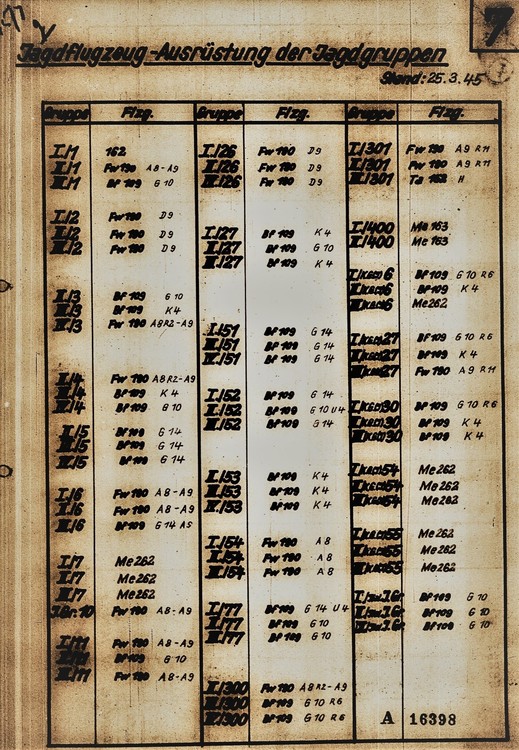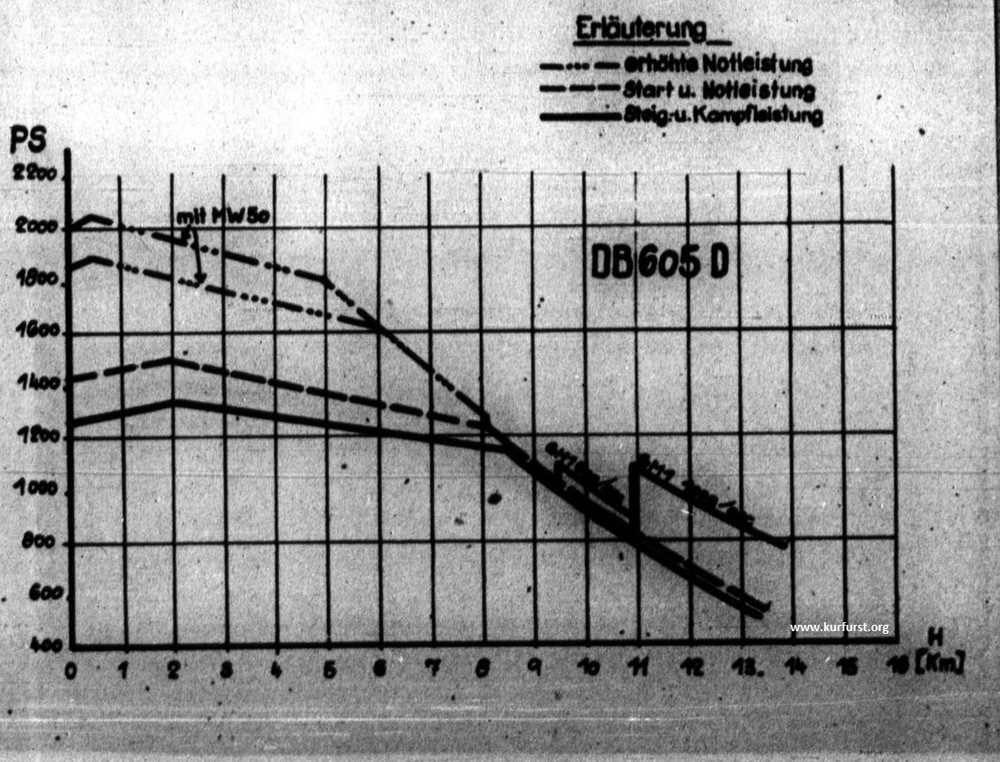-
Posts
861 -
Joined
-
Last visited
-
Days Won
1
-
Mike Force Team started following Kurfürst
-
It depends on which variant, real life or sim-environment. In real life maximum power was used only in exceptional circumstances, even in combat. The K-4 (also G-14/AS, G-10) used high altitude engines with larger superchargers, and with broad bladed propellers, with added therefore their low-medium altitude performance was slightly inferior compared to the old models. For this reason, one our pilots, Lt. Tobak, who had received a new G-10 commented that a G-6 or G-14 would be preferable to his G-10 under 6000 meters. He would be using As for the G-6 without MW boost is much lighter than the K-4 (3,1 t at takeoff vs 3,36 t when fully loaded), and it has a takeoff power of 1475 PS (1.42ata) vs. our K-4 at 1850 PS (1.8ata w. MW). That's 475 PS / t vs 550 PS / t when you look at the base metrics. Without MW the K-4 is getting only 1430 PS (1.45ata), making its power to weight ratio 'only' 425 PS / t, so you get the idea why Tobak made comments like he made - in normal use the newer planes were carrying more weight per horsepower and felt heavier than the old versions. The major difference is that the A series engines (MW or not) will start to run out of umph above cc 5000 meters, while the AS/D series engines remain very lively up to about 8 km thanks to the bigger supercharger. The price paid was that the big supercharger sapped about 40 PS more from the propeller shaft. When we talk about very late, DDay era G-6s with MW boost (later renamed G-14 in this configuration (the G-6 is a bit superior to the K-4 up to about 4000 m, as it will have more power for the (slightly increased) weight it carries. The speed will still go slightly to the K-4 for its aerodynamic refinements benefit it, but most other metrics (turn, climb, acceleration) will be better on the G-6/G-14 w. MW. Then again, we have the K-4 at 1.8 ata manifold pressure, when the engine was set to the 1.9ata or 1.98ata manifold pressure there was no competition due to the power increase. Late AM engines (renamed AB) only went up to 1.8ata.
-
I agree, it would be a nice addition to the K-4 module, if that’s what you meant.
-
I have seen real life test where they run the engine for 40 mins on max power before breaking. Really as long as you are within operation limits, it should be fine except for the greater wear on the engine components. At higher than rated altitudes, not even that, as the engine no longer develops full power.
-
Then its spot on. The Germans specs (thin continuous line) are cc. 694 kph at 9000 m for our 1,8 ata boost variant, though the papers mention that Mach correction is not present in the calculation and should amount to about cc. 5 kph correction. 5026-27_DBSonder_MW_geschw.jpg (1864×1240) (kurfurst.org)
-
I count 11 Wings (Gruppen) with K-4 and 6 Gruppen with D9. And we are not even getting into counting G10s and G-14AS, which is pretty much the same thing for all practical purposes as the K4. This is not common. Somehow. Yet, that single Wing (or one and a half, if you count recce variants in units mixed with Mustangs) of Mk XIV was somehow 'common'. Oh-kay.
-
To me it seems the answer is the difference in use, hence two different systems for Jabo (C-3 injection, but only in the first stage) and Jager (no C-3 injection, simple manifold pressure increase, usable in both stages, but only in flight). Rechlin and various notes that with the Jager system (EN) the cylinder and oil temperatures are near the limit, but acceptable. Charge coolig and detonation is probably less an issue, since C-3 can more than take it, but temperatures can be. The real eye opener is IMO the limitation to use in in flight only on the EN system, i.e. it cannot be used for takeoff. Jabos in contrast to fighters may need to use the boost for take off on short airfields and/or when heavily loaded, without proper air cooling for the cyliders, and possibly for prolonged periods at low altitude in the summer heat. They need the extra charge cooling from additional C-3 injection, and they probably do not use it at higher altitudes anyway.
-

Performance of the DB605DB with 9-12159 propeller
Kurfürst replied to Fenderalac's topic in DCS: Bf 109 K-4 Kurfürst
Indeed, especially on the earlier 605As GM1 injection was very brutal for the time, and came in on more common altitudes. Also there is good power indeed (its a big supercharger), the most impressive thing about IMO that it comes all altitudes. No zigzag power drops like on Merlins and BMWs, due to variable speed hydraulic coupling on the charger drive. -

Performance of the DB605DB with 9-12159 propeller
Kurfürst replied to Fenderalac's topic in DCS: Bf 109 K-4 Kurfürst
-

Eurpean thatre : Normandy Approrpiate Bf109?
Kurfürst replied to Kev2go's topic in Western Europe 1944-1945
The light alloy tank itself curiously added zero, as it weighted 32 kg but it was built in the place of the laminated dural armoured bulkhead behind the fuel tank, which was removed to make place for the tank and which also weighted 32 kg, so they cancelled out each other. The mw liquid weighted about 1 kg / liter, and 70 to 85 liter seems to be the official norm, though in practice it could be more or less. So the liquid itself adds about 70-75 kg. The tank itself had a volume of 115 litres. On the 109K it could be tapped fully with fuel as well, and CoG would remain still the same because of lower density of fuel. I agree that the other high altitude 109s would be a waste of time, as they are almost entirely identical to the 109K in performance (the only meaningful difference is that they are a bit slower, purely due to aerodynamics). F-4 would be totally out of place, as it was long retired by this time. Gs almost completely replaced it by 1943. -

Eurpean thatre : Normandy Approrpiate Bf109?
Kurfürst replied to Kev2go's topic in Western Europe 1944-1945
Well, it’s worth considering that if you have no MW 50 booster in the tank, the G-14 becomes a (from the visual point of view late production) G-6 performance wise. You can have two aircraft for the price of one. It’s also worth considering that while the standardised late G-6 under the designation did indeed came into production and use over Normandy in July 1944, de facto equivalents in the form of G-6s retrofitted with MW boost did exist and were used for some months by that time. In fact the official description of the G-14 in German type sheet suggest that the main difference between the G-6 and G-14 by that time was that the former used pressurised bottles to actuate the mw system while the latter tapped the supercharger for the same purpose. -
Could this be because the intercooler on the Spit and Mustang perhaps? Is it on a separate coolant fluid cycle I wonder...?
-
This does not sound like historical accuracy at all. It sounds like the Standard Allied Dream That Repeats Itself on Every WW2 Flight Sim Board, the desire for conditions síita le for trashing the poorest possible opposition while flying the best / fiction / semi-fictional / ultra rare Allied aircraft at the highest possible performance ratings one can dream of. Fun fact - due to a bug in the K-4's drag model that existed for some time (and has been corrected long ago), the 109K had a lot more drag than it should have and it basically had the performance of a G-6/AS (in fact less, as it still had more weight) Guess when the whining about flying against Axis aircraft that are 'too good' was at its peak - that's right, when they were actually flew against a G-6/AS that historically even preceded the introduction P-51D by a couple of months...
-
You would probably have to take a deep look at the control scheme to figure out whether it is correct or not.However, such a system would make sense if the radiator flaps were really just two fixed positions and no intermediate positions like on the 51 or 109. It is a bit crude way to control temp and drag, though.
-
Interesting. Would it be the case that the real thing only opened up when the temp was becoming really hot, but at the same way, only closed again when it cooled down sufficiently? I.e. there were two separate regulating temperatures, and in between, the shutters were just "off"...?
-
Well it is normal I believe, it is a Spitfire IX after all and it’s not supposed to be very fast. 530ish seems fairly good from it. Or perhaps the current versions is no longer based on and/or tries to match far too optimistic results obtained on one off prototypes or flight tests with weird anomalies present?






